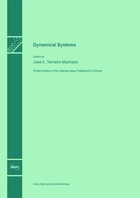Dynamical Systems
A special issue of Entropy (ISSN 1099-4300). This special issue belongs to the section "Complexity".
Deadline for manuscript submissions: closed (31 August 2013) | Viewed by 233234
Special Issue Editor
Interests: nonlinear dynamics; fractional calculus; modeling; control; evolutionary computing; genomics; robotics, complex systems
Special Issues, Collections and Topics in MDPI journals
Special Issue Information
Complex systems are pervasive in many area of science and we find them everyday and everywhere. Examples include financial markets, highway transportation networks, telecommunication networks, world and country economies, social networks, immunological systems, living organisms, computational systems and electrical and mechanical structures. Complex systems are often composed of large number of interconnected and interacting entities exhibiting much richer global scale dynamics than they could be inferred from the properties and behaviour of individual entities. Complex systems are studied in many areas of natural sciences, social sciences, engineering and mathematical sciences.
The special issue focus on original and new research results on systems dynamics in science and engineering. Manuscripts in complex dynamical systems, nonlinearity, chaos and fractional dynamics in the thermodynamics or information processing perspectives are solicited. We welcome submissions addressing novel issues as well as those on more specific topics illustrating the broad impact of entropy-based techniques in complexity, nonlinearity and fractionality.
Specific topics of interest include (but are not limited to):
- Complex dynamics
- Nonlinear dynamical systems
- Advanced control systems
- Fractional calculus and its applications
- Chemical dynamics
- Economical dynamics and predictions
- Dynamical systems synchronization
- Biological systems and bioinformatics
- Nonlinear waves and acoustics
- Image and signal processing
Guest Editor
Benefits of Publishing in a Special Issue
- Ease of navigation: Grouping papers by topic helps scholars navigate broad scope journals more efficiently.
- Greater discoverability: Special Issues support the reach and impact of scientific research. Articles in Special Issues are more discoverable and cited more frequently.
- Expansion of research network: Special Issues facilitate connections among authors, fostering scientific collaborations.
- External promotion: Articles in Special Issues are often promoted through the journal's social media, increasing their visibility.
- e-Book format: Special Issues with more than 10 articles can be published as dedicated e-books, ensuring wide and rapid dissemination.
Further information on MDPI's Special Issue polices can be found here.







